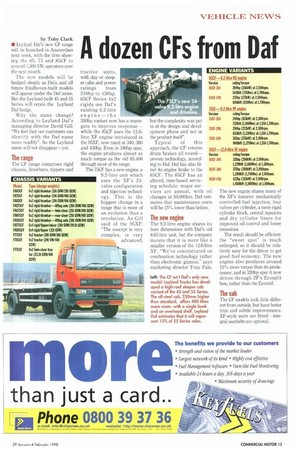A dozen CFs from Daf
Page 15

If you've noticed an error in this article please click here to report it so we can fix it.
by Toby Clark
• Leyland Dar s new CF range will be launched in Amsterdam next week, with the firm showing the 65, 75 and 85CF to around 1,500 UK operators over the next month.
The new models will be badged simply as Dafs, and all future Eindhoven-built models will appear under the Daf name. But the Leyland-built 45 and 55 Series will retain the Leyland Daf badge.
Why the name change? According to Leyland Daf's managing director David Gill: "We feel that our customers can identify with the Daf name more readily". So the Leyland name will not disappear—yet.
The range
The CF range comprises rigid chassis. drawbars, tippers and tractive units, with day or sleeper cabs and power ratings from 210hp to 430hp. 65CF Series 4x2 rigids use Daf's existing 6.2-litre engine—the 240hp variant now has a wastegate to improve response— while the 85CF uses the 12,6litre XF engine introduced in the 95XF, now rated at 340, 380 and 430hp. Even in 340hp spec, the engine produces almost as much torque as the old 85.400 through most of its range.
The 75CF has a new engine, a 9.2-litre unit which uses the XF's 24valve configuration and injection technology. This is the biggest change in a range that is more of an evolution than a revolution. As Gill said of the 95XF: "The concept is very complex. is very advanced, . but the complexity was put in at the design and development phase and not in the product itself", Typical of this approach, the CF retains drum brakes all round— proven technology, according to Daf. Daf has also fitted its engine brake to the 85CF. The 85CF has an altered, time-based servicing schedule: major services are annual, with oil changes at 50,000km. Daf estimates that maintenance costs will be 15% lower than before.
The new engine
The 9.2-litre engine shares its bore dimensions with Des old 8.65-litre unit, but the company insists that it is more like a smaller version of the 12.6-litre XF. "We've concentrated on combustion technology rather than electronic gizmos," says marketing director Tony Pain. The new engine shares many of the XF's features: mechanically controlled fuel injection, four valves per cylinder, a more rigid cylinder block, central injectors and dry cylinder liners for improved oil control and lower emissions.
The result should be efficient: the "sweet spot" is much enlarged. so it should be relatively easy for the driver to get good fuel economy. The new engine also produces around 15% more torque than its predecessor, and in 320hp spec it now drives through ZF's Ecosplit box, rather than the Ecomid.
The cab
The CF models look little different from outside, but have better trim and subtle improvements. XF-style seats are fitted--integral seatbelts are optional.












































































































